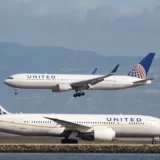Boeing and Alaska Airlines Under Fire as $1B Lawsuit Goes to Court
Aerospace giant Boeing and airline operator Alaska Airlines find themselves in the crosshairs of a billion-dollar lawsuit filed by three passengers of Flight 1282. The incident in question? A harrowing mid-flight emergency caused by a blown-out door plug on a Boeing 737 MAX 9 jet, sparking fears and raising serious questions about the safety of these aircraft.
For the passengers involved, what was meant to be a routine journey quickly escalated into a nightmare scenario. As Flight 1282 soared through the skies, en route to its destination, the sudden rupture of a door plug sent shockwaves through the cabin, triggering panic and prompting an emergency landing. While thankfully no injuries were reported, the psychological toll of such a traumatic experience cannot be understated.
Now, as the dust begins to settle and the initial shock wears off, attention turns to the root causes of this alarming incident. How could a seemingly innocuous component failure lead to such a potentially catastrophic outcome? And who bears responsibility for ensuring the safety and well-being of passengers aboard these aircraft?
Enter Boeing and Alaska Airlines – two titans of the aviation industry whose reputations now hang in the balance. For Boeing, still reeling from the fallout of the 737 MAX crisis that gripped headlines not long ago, this latest development serves as a stark reminder of the perils of cutting corners and prioritizing profit over safety. While the company has made strides in addressing previous concerns and implementing enhanced safety measures, incidents like the one involving Flight 1282 serve as a sobering reality check.
As for Alaska Airlines, whose fleet includes a significant number of Boeing 737 MAX jets, the lawsuit represents a potentially damning blow to its reputation as a reliable and trustworthy carrier. With passenger safety rightfully taking center stage in the wake of this incident, the airline faces tough questions about its maintenance protocols, oversight mechanisms, and commitment to ensuring the airworthiness of its fleet.
But beyond the legal wrangling and finger-pointing lies a deeper issue – one that extends far beyond the confines of this single flight or the boundaries of any courtroom. It’s a question of trust. Trust in the aircraft we board, the companies that manufacture them, and the airlines that operate them. Trust that is earned through transparency, accountability, and a steadfast commitment to putting safety above all else.
In the aftermath of this ordeal, it’s imperative that Boeing, Alaska Airlines, and the broader aviation industry as a whole take a long, hard look in the mirror and ask themselves some tough questions. Are we doing enough to ensure the safety of our passengers? Are we prioritizing profits over people? And perhaps most importantly, are we living up to the sacred trust placed in us by those who take to the skies each and every day?
As the legal battle unfolds and the truth behind the events of Flight 1282 comes to light, one thing remains abundantly clear – the safety and well-being of passengers must always come first, no matter the cost. Anything less is simply unacceptable.






